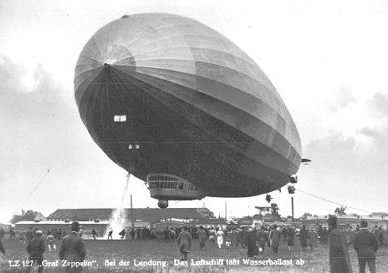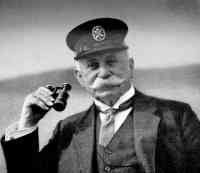|
ZEPPELIN
|
||
|
HOME | BIOLOGY | FILMS | GEOGRAPHY | HISTORY | INDEX | INVESTORS | MUSIC | SOLAR BOATS | SPORT |
||
|
Zeppelins are a type of rigid airship pioneered by German Count Ferdinand von Zeppelin in the early 20th century, based in part on an earlier design by Croatian aviation pioneer David Schwarz. Due to the outstanding success of the Zeppelin design, the term zeppelin in casual use came to refer to all rigid airships.
Zeppelin were used for passenger transport as well as for military purposes, operated by the Deutsche Luftschiffahrts-AG (DELAG). DELAG is the first commercial airline, served scheduled flights before World War I. After the outbreak of the war, the German military made extensive use of Zeppelins as bombers and scouts.
LZ127 Graf Zeppelin transatlantic airship
The German defeat halted the airship business temporarily, but under the guidance of Hugo Eckener, the successor of the deceased count, civilian Zeppelins experienced a renaissance in the 1920s. They reached their zenith in the 1930s, when the airships LZ 127 Graf Zeppelin and LZ 129 Hindenburg operated regular transatlantic flights between Germany and both North and South America. The Hindenburg disaster in 1937 triggered the fall of the "giants of the air", though other factors, including political issues, contributed to the demise of the Zeppelin.
Principal characteristics
The most important feature of Zeppelin's design is a rigid aluminium alloy skeleton, made of rings and longitudinal girders. The advantage of this concept is they can be built much larger, which enables them to lift heavier loads and be equipped with more numerous and powerful engines than non-rigids, commonly known as blimps, which rely on a slight overpressure within the single gasbag to maintain their shape.
The overall form of the first Zeppelins was cylindrical with rounded ends and complex multi-plane empennage. During World War I, as a result of improvements by the competing firm of Schutte-Lanz Luftschiffbau, the design was changed to the familiar streamlined shape and cruciform empennage used by almost all airships since. Within this outer envelope, several separate balloons, or "cells", contained the lighter-than-air gas hydrogen. Non-rigid airships do not have multiple gas cells. Motive power was provided by several internal combustion engines, mounted in nacelles rigidly connected to the skeleton. Steering was made possible by adjusting and selectively reversing engine thrust and by using rudder and elevator fins.
A comparatively small compartment for passengers and crew was built into the bottom of the frame, but in large Zeppelins this is not the entire habitable space; they often carried crew or cargo internally for aerodynamic reasons.
History
The first generations
Count Ferdinand von Zeppelin became interested in constructing a "dirigible balloon" after the Franco-Prussian War of 1870/1871, where he witnessed French use of them to transport mail during the siege of Paris. He had also encountered Union Army Balloon Corps employment in 1863, during the American Civil War, as a military observer with the Union Army. He began to seriously pursue his project after his early retirement from the military in 1890 at the age of 52.
Convinced of the potential importance of aircraft, he started working on various designs shortly after leaving the military. He eventually purchased the rights to the designs of Croatian inventor David Schwarz after that inventor died suddenly before successfully flying, drawing heavily on Schwarz's design.
On August 31, 1895, von Zeppelin obtained a patent which already included most of the aforementioned features. One unusual idea, which never saw service, was the ability to connect several independent airship elements like train wagons; in fact, the patent title called the design Lenkbarer Luftfahrzug (steerable air-cruising train).
Ferdinand von Zeppelin
An expert committee to whom he had presented his plans in 1894 showed little interest, so the Count was on his own in realizing his idea. In 1898 he founded the Gesellschaft zur Förderung der Luftschiffahrt (company for the promotion of airship flight), contributing more than half of its 800,000 Mark share capital himself. He forced the technical implementation to the engineer Theodor Kober and later to Ludwig Dürr.
Construction of the first Zeppelin began in 1899 in a floating assembly hall on the Bodensee in the Bay of Manzell, Friedrichshafen. This location was intended to facilitate the difficult launching procedure, as the hall could easily be aligned with the wind. The prototype airship LZ1 (LZ for Luftschiff Zeppelin, or "Airship Zeppelin") had a length of 128m (420ft), was driven by two 14.2hp (10.6 kW) Daimler engines and was balanced by moving a weight between its two nacelles.
The first Zeppelin flight occurred on July 2, 1900 over the Bodensee. It lasted only 18 minutes before LZ1 was forced to land on the lake after the winding mechanism for the balancing weight broke. Upon repair, the technology proved its potential in subsequent flights (the second and third flights were in October 1900 and October 24, 1900 respectively), beating the 6 m/s velocity record of the French airship La France by 3 m/s. This performance, however, was unable to convince possible investors. With his financial resources depleted, Count von Zeppelin was forced to disassemble the prototype, sell it for scrap, and close the company in 1901.
It was largely due to support by aviation enthusiasts von Zeppelin's idea got a second (and third) chance and could be developed into a reasonably reliable technology. Only then could the airships be profitably used for civilian aviation and sold to the military.
Donations and the profits of a special lottery, together with some public funding and a further combined with a mortgage of Count von Zeppelin's wife's estate and a few funds allowed him for the construction of LZ2, which took off for the first and only time on January 17, 1906. After both motors failed, it made a forced landing in the Allgäu mountains, where the anchored ship was subsequently damaged beyond repair by a storm.
Incorporated all usable parts of LZ2, the successor LZ3 became the first truly successful Zeppelin, which by 1908 had travelled 4398km in total in the course of 45 flights. The technology then interested the German military, who bought LZ3 and renamed it Z I. She served as a school ship until 1913, when she was decommissioned as obsolescent.
The army was also willing to buy LZ4, but requested a demonstration of her ability to make a 24 hour trip. While attempting to fulfil this requirement, the crew of LZ4 had to make an intermediate landing in Echterdingen near Stuttgart. During the stop, a storm tore the airship away from its anchorage in the afternoon of August 5, 1908. She crashed into a tree, caught fire, and quickly burnt to ruins. No one was seriously injured, though two technicians repairing the engines escaped only by making a hazardous jump. This accident would have certainly knocked out the Zeppelin project economically had not one of the spectators in the crowd spontaneously initiated a collection of donations, yielding an impressive total of 6,096,555 Mark. This enabled the Count to found the Luftschiffbau Zeppelin GmbH (Airship Construction Zeppelin Ltd.) and a Zeppelin foundation.
Zeppelin Luftschifftechnik GmbH — The original company, now developing the Zeppelin NT
AVIATION A - Z
A taste for adventure capitalists
Solar Cola - a healthier alternative
|
||
|
This
website
is Copyright © 1999 & 2013 NJK. The bird |
||
|
AUTOMOTIVE | BLUEBIRD | ELECTRIC CARS | ELECTRIC CYCLES | SOLAR CARS |

